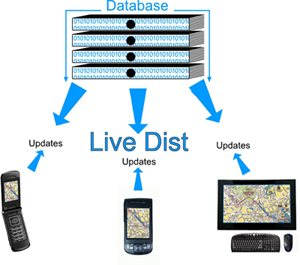We supply middleware solutions for cost-effective, efficient, selective, scalable, and near real-time database replication. We call it database distribution.

What is real-time database distribution?
Common problems in real-time data-distribution:
- Clients have different views on the database.
-
Network topology is constantly changing.
New clients can join the network and existing client can leave the network, at any time. - Clients need to change their subscription.
- Some clients are connected over low-bandwidth communications, while others are connected over high-bandwidth communications.
- Data must be sent to each site only once.
In what ways are our products efficient?
We support multi-site topology, in which each delta is sent only once to each site (and only when it is of interest to at least one client in the site). Our proxy servers receive incoming distribution from their mother-site and serve all clients in their local site.
We support concurrent and fast loads from our servers and our proxies to clients, with zero overhead on the database. Three kinds of loads are supported:
- Full loads to new joining clients.
- Partial loads to existing clients when clients change their subscription.
- Sync loads to clients rejoining after being disconnected for a long time.
When a client reconnects to the distribution servers after a short disconnection period (a few minutes) no load is required, and the client can immediately resume its reception of steady-state distribution.
What is selective distribution?
At the server-side: A list of topics (each topic is a string, whose format is a convention between the server and the clients) is attached to each hierarchical entity in the database. Business logics can assign topics to created entities, and are also allowed to update the topics-list of existing entities.
Each client: defines a topics-slice to express its interest in the entities selected by the slice. A client can change its subscription (topics-slice) whenever it needs to.
The meaning of topics:
Each topic belongs to one of two kinds of topics:
- The name of a client or a group of clients. When a topic of that kind is attached to an entity, the entity is distributed to the specified client or group of clients. It is assumed that each client specifies in its topics-slice the client-name and the names of all groups of clients it is a member of.
- A name representing an attribute of the entity. This enables clients to select all entities having the attributes that are of interest to them.
How near are we to real-time database distribution?
Scalability
The distribution servers can run on multi-processor machines, and fully utilize all processors. To achieve this a very efficient locking algorithm is used, in which the internal data-structures are not read-write locked for long time-periods.
A cost effective solution
The distribution servers (both delta-server and cache-servers) run on low-cost blade machines. The cost of each server machine is approximately $1500.
DB to DB distribution
use-case:
Many to many:
In this model, the database is distributed over
a set of database servers. The products are
used for handling distribution between server machines.
Flexible topology:
Each database server is directly
connected to some other database servers,
and it distributes its local database to
all directly connected database servers.
Selective:
Each database-server defines a topics-slice
per each directly connected database-server for
selecting entities from the other database-server.
No master:
There is no master server. Each database server
is allowed to modify all entities (including their
topics-lists) at any time.
Changing topology:
The set of database servers which are directly
connected to a specific database server can change
at anytime. Dynamic changes of topology are possible
due to fast synchronizations and the
registration mechanism.
A proven technology:
Our software is used by mission critical systems!
Source-code included:
We sell LiveDist(C#) and LiveDist(Java) as open-source. Thus, our customers have no long run dependency on us.
Internals course:
Customers who wish to self-maintain
LiveDist(C#) or LiveDist(Java), can order internal
courses for their software engineers.
These courses assist them to fully
understand the internal behavior
of the distribution products.
DB to clients distribution
use-case:
Full-load:
When a client first joins the network,
it defines a topics-slice. This causes a
frozen snapshot of the database, containing
all database entities selected by the slice,
to be downloaded to the client
Gap-closing:
The database continues to process transactions
during the snapshot download period. This causes
a gap to open between the client and the database.
Following the snapshot load, the client receives
a burst of deltas, in order to close the gap.
Steady-state:
After closing the gap, the client enters
steady state, in which it receives
deltas whenever entities that are selected
by the topics-slice are inserted into,
updated in, or deleted from the database.
Partial-load:
The client can change its subscription, by redefining
its topics-slice. This causes a partial-snapshot
to be loaded to the client, containing all entities
not selected by the old slice but selected by the
new slice
The distribution products:
LiveDist(Java) and LiveDist(C#) are similar products, running on different platforms.
LiveDist(Java):
A Java product (J2EE). Supported databases: Oracle.
LiveDist(C#):
A C# product (.Net). Supported databases: SQL-Server, Oracle.
Read more...
